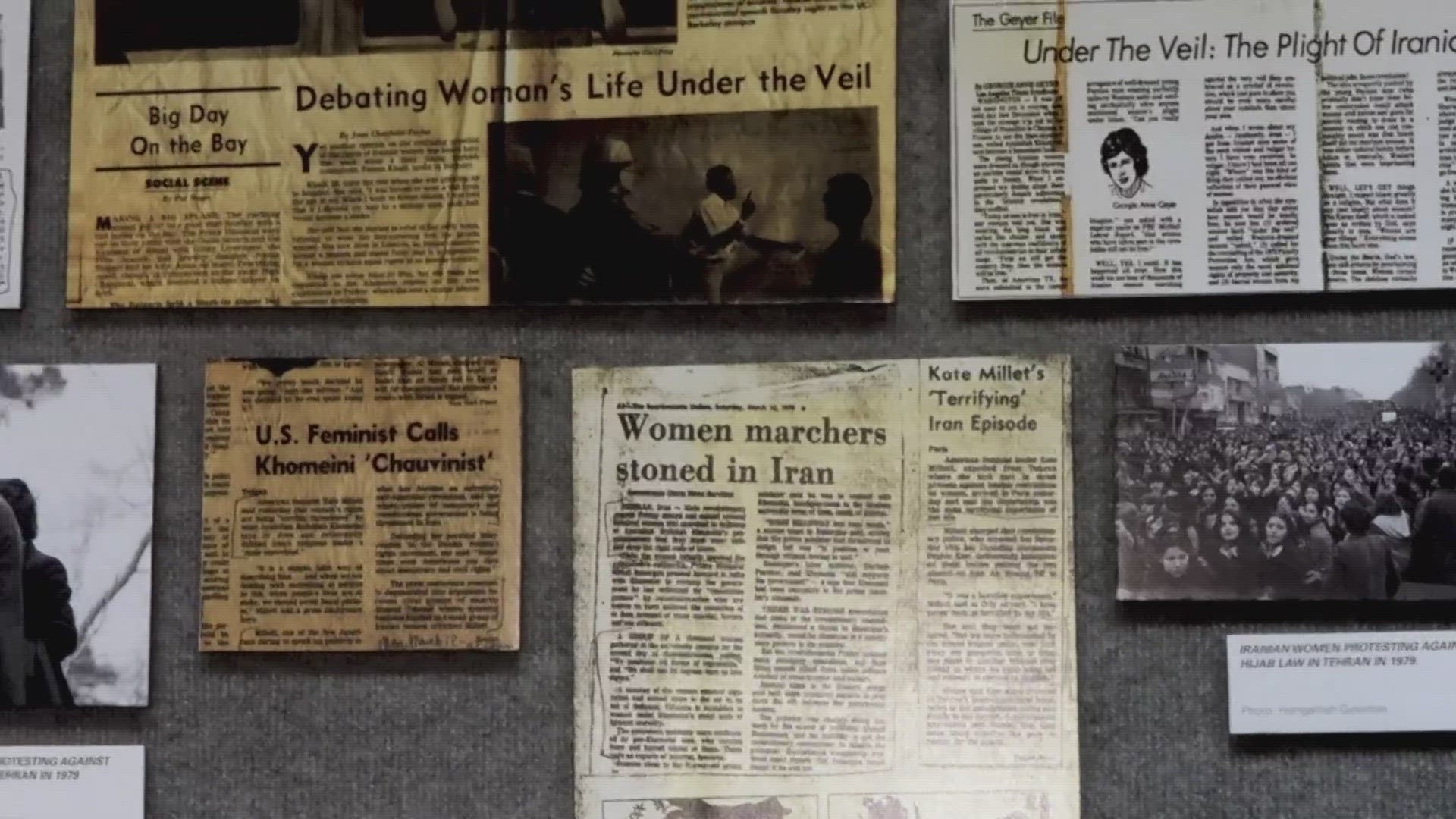SACRAMENTO, California — A new exhibit at Sacramento State details the struggle for women’s rights in Iran through art, fashion, poetry and history.
Late last year, Mahsa Amini, a young Kurdish-Iranian woman, died in the custody of Iran's morality police after being detained for allegedly wearing her hijab improperly, which violated the country’s strictly enforced Islamic dress code imposed on women. Her death ignited nationwide protests led by women and young people condemning Iran’s authoritarian regime, a movement supported around the world, including in the greater Sacramento region.
“Jin, jiyan, azadi!" — or "Woman, life, freedom!" became the rallying cry. More than 530 people were killed and over 22,000 arrested by Iran’s security forces during the protests.
For Jaleh Naasz, an Iranian immigrant and lecturer for the Fashion Merchandising and Management department at Sacramento State, she felt deeply connected to the issues in her home country and inspired by the movement, she created “The Seen Iranian Woman” exhibition.
“As an Iranian, I wanted to have a place to process what is happening,” said Naasz. "As an educator, I wanted to have a place where people felt more informed on the topic. There isn't a lot of information that we learn about Iran and Iranian people."
Visually dynamic, the exhibition not only includes news clippings, paintings, silk screens, social media posts, poetry, books and photos about women's rights in Iran, it also displays a historical curation of women’s fashion throughout the last century dictated by Iranian law.
“I really hope that when people walk through this exhibit they can visualize how quickly things can change, how quickly a society can change, how gradual laws can make dramatic shifts and how easily women's rights can be jeopardized,” said Naasz.
Wearing a hijab headscarf has been mandatory for all women in Iran since 1983. Days after the one-year mark of Amini's death, Iran’s parliament passed a stricter law to impose heavier penalties on women who refuse to wear the mandatory Islamic headscarf in public.
“The compulsory hijab has become a tool to torture, to restrict, and to make women a secondhand citizen,” said Minoo Safai-Amini, a mixed-media artist whose work is part of the exhibition.
Mahsa Amini’s death prompted Safai-Amini to shift her artistic endeavors towards activism.
“Art is an avenue for showing what is going on in its time period,” said Safai-Amini. “I’m hoping that my art can speak to the reality and life of miseries that women in Iran are facing.”
She created five pieces of work for the exhibition, including “Misogyny." The silkscreen is of an Iranian woman in the backdrop of her city wearing the “proper Islamic cover” while donning boxing gloves, a symbol of Iranian women and girl’s resiliency in a country where they are still fighting for their rights.


Like Safai-Amini, Naasz felt compelled to use her skillset to spotlight the ongoing atrocities happening in Iran.
“The ‘Fallen Not Forgotten’ leaf dress was my way of mourning the losses of the insane number of people that were murdered by writing their names on the leaves, and then by attaching the leaves to the gown,” said Naasz.
The dress is on display at the exhibition along with other garments she created.


Fashion has always been a huge part of her life whether it was growing up in Iran under strict dress codes or changing her style when she immigrated to the United States to fit into Western culture.
One of Naasz’s favorite courses to teach is “Clothing, Culture and Society,” which looks at how people dress, why people present themselves the way they do and how people communicate based on how one another is dressed.
She believes fashion is all about self-expression and as a whole it can be used as a political tool to stand up for your rights.
Whether it's because of the art or fashion, Naasz hopes people who visit the exhibit leave with a better understanding of the conditions in Iran.
“One of the main messages coming out of Iran was, ‘Be our voice. Listen to us,’” said Naasz. “These people were sending videos of themselves, they were sharing their stories, knowing that their life was on the line for doing that. And so, anyone who is in a position to listen to that, to hear it, to watch it, and to talk about it and to share it, I find that to be extremely important, both for the people there and also for the people here.”
Naasz said all are welcome to visit "The Seen Iranian Women" exhibit. It will be on display in the University Union Gallery through Nov. 16 with a closing reception from 6-8 p.m.
We want to hear from you!
The Race and Culture team's mission is to serve our diverse communities through authentic representation, community engagement and equitable reporting. Accomplishing our goals of inclusive reporting requires hearing from you. Is there a person or place that you want us to highlight? Email us at raceandculture@abc10.com or fill out the form below.

